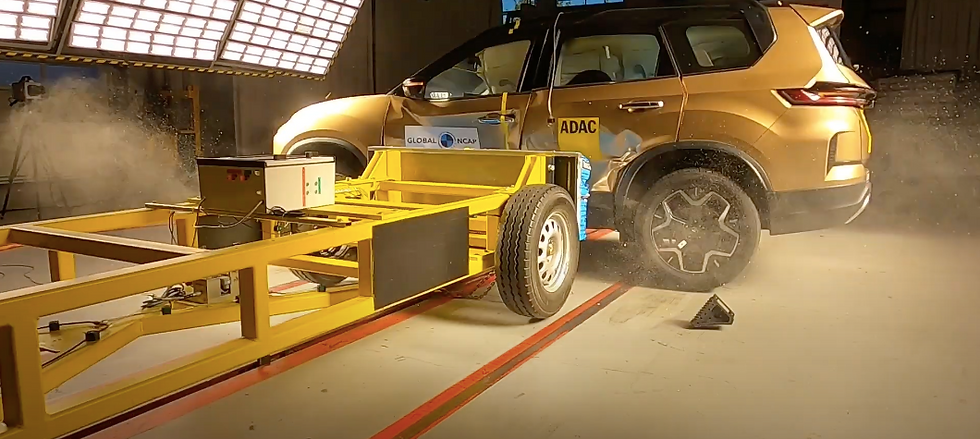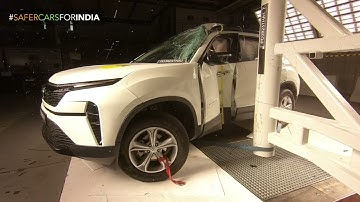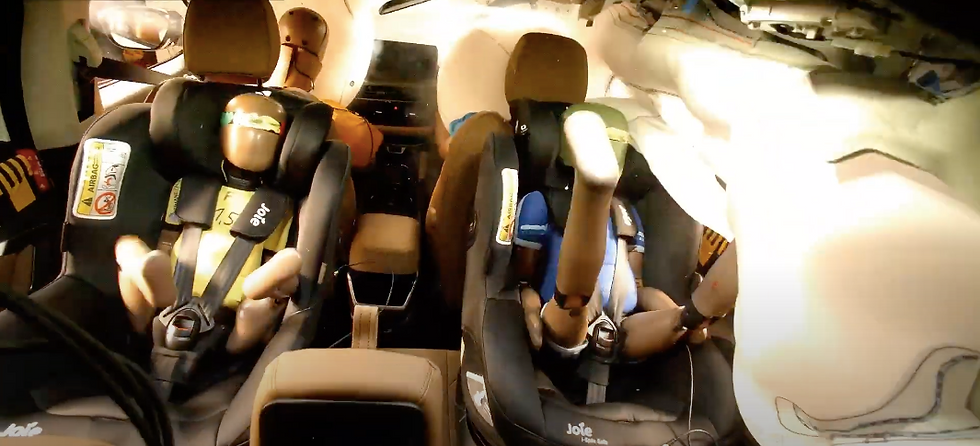Global NCAP's Stars Shine on Tata's Twins
- Gobar NCRAP
- Oct 17, 2023
- 4 min read

Global New Car Assessment Programme (Global NCAP), the UK-based consumer-testing organisation who have been known to issue crashworthiness ratings for new passenger vehicles sold in developing economies, have announced the latest set of results for their #SaferCarsForIndia project.
In their latest release, Tata's recently updated Safari and Harrier large SUVs score top marks, with five-star ratings for adult and child occupant protection, and exceptionally robust scores in both areas of assessment.
The Safari and Harrier were earlier fitted as standard with electronic stability control, while six airbags (2 frontal airbags, 2 side body-protecting airbags and 2 head-protecting curtains for the first two rows) and ISOFIX anchorages were only optional. Now, all of these safety technologies have become standard equipment, in addition to three-point safety belts in all seating positions, curtain airbag coverage for the third row (in the case of the Safari), i-Size compatible rear seats, and reminders with occupant detection for the front and rear safety belts. Also available as optional equipment are a driver knee airbag and a suite of advanced safety assist technologies, including Automatic Emergency Braking and a Lane Departure Warning.
Global NCAP tested the Harrier and Safari at Tata's expense, and the SUVs were assessed against their latest assessment criteria for the 2023 model year (found on the webpage www.globalncap.org/resources).

In the offset frontal impact test, a Safari unit was driven into a deformable barrier at 64km/h, with 40% of its width overlapping with the barrier and two belted average adult male dummies in the front seats. This test intends to simulate the characteristics of a crash between two similar SUVs each travelling at 50km/h, with half their fronts overlapping. During the test, the driver's head made stable contact on the airbag and steering wheel displacement was negligible. Dummy readings showed a low risk of serious injury to most body regions, and a limited risk of fracture for the driver's ribs and tibias. The passenger compartment held its shape well during the test; no significant displacement of the A-pillar was reported and no penalty was applied; additionally, after inspection of the vehicle's load transfer paths, the passenger compartment was judged to have remained stable during the test. Intrusion of the pedals was negligible, and spot welds in the footwell were retained. Tata demonstrated that the knees of occupants of different sizes or seating positions would be protected similarly against impact with hard structures behind the fascias.

In the side impact test, a 950kg mobile deformable barrier representing a small car was driven into a Safari unit's front passenger-side door at 50km/h, with a belted average adult male dummy in the front passenger seat. Dummy readings indicated a low risk of serious injury to the driver's head, chest abdomen and pelvis.

In the pole side impact test, differences in wheelbase meant that a unit each of the Harrier and Safari was driven laterally on a sled at 29km/h, into a rigid pole representing a tall, fixed object, targeted at a belted front passenger's head. Dummy numbers from the test indicated a moderate risk of serious rib fracture for the driver, and a limited risk of serious injury to his abdomen, but the curtain airbags worked well to prevent hard contact of his head with the intruding pole.

The Safari was found to comply with UN Regulation No. 127, where a series of adult and child headform impactors strike different locations on the hood, and a lower leg impactor strikes the car's bumper. Its electronic stability control system was also found to pass the robotised sine-dwell steering manoeuvre in the UN's Regulation R13-H. Global NCAP awarded the Safari two additional points for its intelligent safety belt reminders, one each for the systems in the front and rear seats.

Tata recommend the following child restraints:
18 month-old child: "Joie i-Spin Safe" (approved accessory), rearward-facing
3 year-old child: "Joie i-Spin Safe" (approved accessory), rearward-facing
Crash test results are always valid only for manufacturer-selected child restraints.
The Safari and Harrier have two i-Size compatible seating positions and three-point safety belts for all seats, and were shown to safely accommodate a variety of child restraints on the market. Both models provide a switch for the disconnection of the front passenger's airbag, should the need to install a rearward-facing child restraint on that seat arise, and according to Global NCAP, they adequately warn of the danger associated with failure to do so. PLACING A REARWARD-FACING CHILD RESTRAINT ON A SEAT WITH AN ACTIVE AIRBAG POSES A RISK OF DEATH OR SERIOUS INJURY!
During dynamic testing, the 18 month-old and 3 year-old child dummies were placed in the child restraints recommended by Tata, installed rearward-facing in the Safari's i-Size compatible outboard rear seats using its ISOFIX anchorages and a foot-prop. Both child dummies were awarded full marks in dynamic testing for front and side impacts.
Gobar NCRAP (not related to Global NCAP) is pleased to announce that the New Safari and New Harrier will be part of an updated comparison of safety features for large SUVs later this week.







Comments